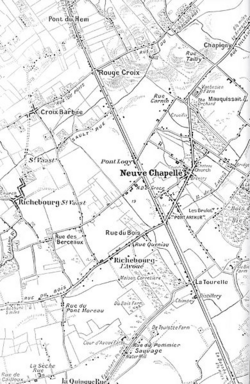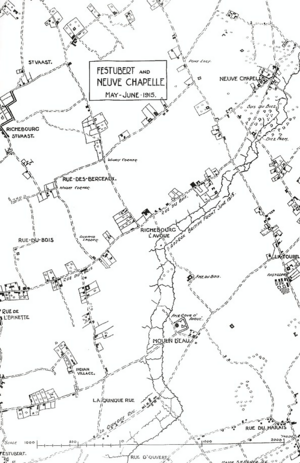Battle of the Boar's Head facts for kids
Quick facts for kids Battle of the Boar's Head |
|||||||
|---|---|---|---|---|---|---|---|
| Part of The Western Front, in the First World War | |||||||
 Richebourg-l'Avoué area, 1914–1916 |
|||||||
|
|||||||
| Belligerents | |||||||
| Commanders and leaders | |||||||
| Douglas Haig | Erich von Falkenhayn | ||||||
| Strength | |||||||
| 2 battalions | |||||||
| Casualties and losses | |||||||
| 850–1,366 | |||||||
The Battle of the Boar's Head was a military attack that happened on 30 June 1916. It took place in Richebourg-l'Avoué, France, during the First World War. British soldiers from the 39th Division attacked a German position. This position was called the Boar's Head. It was a "salient," which means a part of the battle line that sticks out into enemy territory.
Two battalions of the 116th Brigade led the attack. They moved towards the German front lines before dawn. The British soldiers managed to capture the first and second German trenches. They held these trenches for several hours. However, they eventually had to retreat to their own lines. The battle resulted in many casualties for the British, with losses between 850 and 1,366 soldiers.
This battle was part of a larger plan. British armies on the Western Front were supporting the main Battle of the Somme. That bigger battle started on 1 July 1916. The British carried out many smaller attacks, like the Boar's Head. These attacks were meant to keep German troops busy. This stopped them from moving to the Somme front. They also helped new British divisions gain experience.
Contents
Why the Battle Happened
On 1 June 1916, General Charles Monro held a meeting. He was the commander of the British First Army. This army was about 30 miles north of the Somme area. The meeting was about what his army should do. The main goal was to help the British Fourth Army and the French Sixth Army. These armies were about to start a big attack on the Somme.
The First Army's job was to trick the Germans. They needed to make the Germans think a big attack was coming in their area. This would make the Germans use up their resources. It would also stop them from sending soldiers to the Somme. On 7 June, the commander of XI Corps, Lieutenant-General Richard Haking, shared his plan. He said they had dug tunnels and improved old trenches. His divisions planned many small attacks. These attacks would use gas, smoke, and artillery fire. They would happen every day from 26 June to 10 July. They even built models of German defenses to plan these raids.
Getting Ready for Battle
In March 1916, the 39th Division arrived in France. General Haking wanted to promote good soldiers quickly. He believed this would make the army more efficient. It would also make soldiers feel better about their work. Haking was also ready to remove officers who were not performing well. In April, he wanted to replace three brigade commanders with younger men.
The German soldiers were also active. On 26 May, they attacked the 39th Division. From 23 June to 14 July, XI Corps launched 14 raids. Some of these raids went well, others did not. For example, on the night of 20/21 June, 32 British soldiers tried to cross "no man's land." This was the area between the two armies. Their barbed wire was not cut enough. German machine guns caught them, and they had to retreat. Many soldiers were hurt.
On 13 June, soldiers from the 2/4th Royal Berkshire Regiment practiced a raid. They attacked after a bombardment. But most of the German wire was still there. Only a few soldiers reached the German trench. They returned with 38 casualties. This was more than a third of their group. The Germans also raided the 39th Division lines on 29 May. They killed two soldiers and made others drop their rifles. Because of these events, the 39th Division planned a bigger attack. This attack was for the 12th and 13th (Southdowns) battalions of the Royal Sussex Regiment. Their goal was to capture the Boar's Head.
The Attack Begins
The British artillery started firing on the afternoon of 29 June. Their goal was to destroy German defenses and cut their barbed wire. Reports said the shelling was successful. The final bombardment began just before 3:00 a.m. It included smoke shells to hide the attacking soldiers. The 12th and 13th battalions attacked shortly after, around 3:30 a.m. The 11th Battalion helped by carrying supplies.
As the British soldiers crossed no man's land, their guns stopped firing on the first German trench. This allowed German machine gunners to fire at the attacking soldiers. Many British soldiers were hurt. Still, the surviving soldiers of the 13th Battalion reached the German front trench. They then pushed forward to the second trench. They faced more machine gun fire but managed to capture this trench too.
The Germans tried to counter-attack several times, but the British pushed them back. After about 30 minutes, the British soldiers had to pull back. They were running out of ammunition. Also, more and more soldiers were getting hurt. The 12th Battalion faced uncut wire. They still managed to reach the German front line and held it for a short time. Then they also had to retreat. The Germans even shelled their own trenches. This was to hit the British soldiers who had captured them. On 6 July, soldiers from another British battalion found Royal Sussex men still returning from no man's land.
Aftermath
Casualties
In 1938, a British historian named Wilfrid Miles wrote about the battle. He stated that the 116th Brigade had about 950 casualties. Later, in 2012, Michael Senior estimated around 850 casualties. In less than five hours, the three Southdowns battalions of the Royal Sussex Regiment lost many soldiers. They had 17 officers and 349 men killed. This included 12 sets of brothers, with three from one family. About 1,000 more men were wounded or captured. In the regiment's history, this battle is known as "The Day Sussex Died." A soldier named CSM Nelson Carter was given the Victoria Cross after he died. This was for his brave actions in the battle.
Remembering the Battle
The Le Touret Commonwealth War Graves Commission cemetery and memorial is in Richebourg. It was started in November 1914. It was used throughout the war, except when Germans held it. The Le Touret Memorial is part of this cemetery. The Rue-des-Berceaux CWGC Cemetery is also nearby. It is where New Zealand tennis player Tony Wilding is buried. A modern memorial to the Royal Sussex Regiment is in Beach House Park in Worthing, West Sussex.


